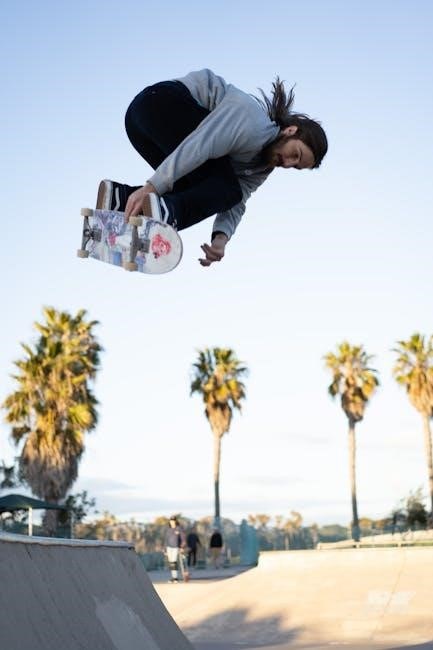Gufoni Maneuver: A Comprehensive Guide
Welcome to a comprehensive guide on the Gufoni Maneuver! This resource provides detailed insights into this therapeutic technique, designed to treat specific types of Benign Paroxysmal Positional Vertigo, offering step-by-step instructions and valuable information for both healthcare professionals and individuals seeking relief.
The Gufoni Maneuver is a specialized therapeutic technique primarily employed to address Benign Paroxysmal Positional Vertigo (BPPV), specifically targeting the horizontal semicircular canal variant. BPPV is a common vestibular disorder characterized by brief episodes of vertigo triggered by changes in head position. The Gufoni Maneuver aims to reposition otoconia, tiny calcium carbonate crystals, that have become displaced from their usual location within the inner ear’s utricle and migrated into the horizontal semicircular canal.
This maneuver is a non-invasive, physical therapy intervention that can be performed by trained healthcare professionals, and with proper guidance, can even be adapted for home exercises. Its effectiveness lies in its ability to guide the dislodged otoconia out of the sensitive horizontal canal, thereby alleviating the distressing symptoms of vertigo and restoring balance. The Gufoni Maneuver offers a valuable alternative to other repositioning techniques, particularly when dealing with horizontal canal BPPV, and is often favored for its relative simplicity and patient comfort. It is essential to differentiate between geotropic and ageotropic variants of horizontal canal BPPV to ensure the correct application of the maneuver, maximizing its therapeutic benefits and minimizing potential complications.
Understanding Horizontal Canal BPPV
Horizontal Canal BPPV, a distinct form of Benign Paroxysmal Positional Vertigo, arises from the displacement of otoconia into the horizontal semicircular canal of the inner ear. Unlike posterior canal BPPV, which is more common, horizontal canal BPPV presents unique challenges in diagnosis and treatment. The horizontal canal is oriented differently, leading to distinct nystagmus patterns during positional testing.
Two main variants exist: geotropic and ageotropic. In geotropic nystagmus, the fast phase of the nystagmus beats towards the ground when the affected ear is down, while in ageotropic nystagmus, the fast phase beats upwards, away from the ground. Accurate identification of the variant is crucial for selecting the appropriate repositioning maneuver, such as the Gufoni Maneuver. Misdiagnosis can lead to ineffective treatment and prolonged symptoms. Understanding the underlying pathophysiology and the specific characteristics of horizontal canal BPPV is essential for healthcare professionals to provide effective and targeted interventions, ultimately improving patient outcomes and quality of life.
Recurrences may also present a poorer response to repositioning maneuvers.
Indications for the Gufoni Maneuver
The Gufoni Maneuver is primarily indicated for the treatment of horizontal canal Benign Paroxysmal Positional Vertigo (BPPV), specifically when the condition is confirmed through diagnostic testing, like the supine roll test. This maneuver is particularly effective for both geotropic and ageotropic variants of horizontal canal BPPV, where nystagmus direction changes with head position. Patients experiencing brief episodes of vertigo triggered by head movements, especially when lying down or turning in bed, may be candidates for this procedure.
Before performing the Gufoni Maneuver, it’s crucial to rule out other potential causes of vertigo, such as Meniere’s disease or central nervous system disorders. A thorough evaluation by a healthcare professional, including a detailed medical history and neurological examination, is essential to ensure accurate diagnosis. The Gufoni Maneuver may also be considered when other repositioning techniques have failed or are contraindicated. Furthermore, patient preference and comfort level should be taken into account when deciding on the most appropriate treatment approach. The maneuver is also very helpful for home treatment of the condition after being shown by a professional.

Step-by-Step Instructions for Performing the Gufoni Maneuver
The Gufoni Maneuver involves specific head and body movements to reposition otoconia within the horizontal semicircular canal. First, the patient sits upright on a flat surface. The patient is then rapidly laid down on their side, toward the unaffected ear, remaining in this position for approximately 30 seconds. Next, without changing the head’s relationship to the shoulder, the body is quickly rotated 90 degrees towards the opposite side, so the patient is now facing downwards, with the affected ear facing the ground. This position is held for another 30 seconds.

Finally, the patient is slowly brought back to the upright seated position. Throughout the maneuver, the patient’s eyes should be observed for nystagmus. If vertigo or nystagmus persists, the maneuver can be repeated multiple times. It is crucial to perform each step precisely and maintain the correct timing to ensure effectiveness. It is highly recommended that the first attempt be done with a healthcare professional to ensure it is done correctly. Patients should avoid sudden head movements for at least 24 hours following the procedure.
Gufoni Maneuver for Geotropic Nystagmus
Geotropic nystagmus, characterized by the eyes beating towards the ground during the supine roll test, indicates a specific presentation of horizontal canal BPPV. When managing geotropic nystagmus with the Gufoni Maneuver, the procedure is tailored to address the movement of otoconia within the affected ear. To begin, the patient sits upright. The patient is then quickly moved to lie down on the side opposite the affected ear, the “good” side. This initial movement aims to shift the otoconia away from the sensitive cupula. The patient remains in this position for approximately 30 seconds, allowing the debris to settle.
Following this, the patient’s head is turned 45 degrees downwards, maintaining the side-lying position. This specific angle is crucial for facilitating the movement of otoconia out of the horizontal canal. The position is maintained for another 30 seconds. Finally, the patient is slowly returned to a seated position. This maneuver is designed to effectively clear the debris. Post-maneuver instructions often include avoiding sudden head movements.
Gufoni Maneuver for Ageotropic Nystagmus
Ageotropic nystagmus, where the eyes beat upward during the supine roll test, presents a unique challenge in horizontal canal BPPV. The Gufoni Maneuver, adapted for ageotropic nystagmus, aims to reposition otoconia that are adhering to the cupula or are located in the short arm of the horizontal canal. This variation of the maneuver begins with the patient seated upright on an examination table. The patient is then quickly moved into a side-lying position on the affected side, unlike the geotropic variant.
This initial movement is crucial in dislodging the debris. The patient remains in this position for approximately 30 seconds. After this period, while maintaining the side-lying position, the head is turned 45 degrees upward. This specific head position is maintained for another 30 seconds. The patient is then slowly returned to the seated position. This adaptation of the Gufoni Maneuver helps facilitate the movement of the problematic otoconia, alleviating the symptoms associated with ageotropic nystagmus.

Modified Gufoni Maneuver Techniques
While the standard Gufoni Maneuver provides a solid foundation for treating horizontal canal BPPV, several modifications have emerged to enhance its effectiveness and address specific patient needs. One notable modification involves incorporating vibratory stimulation to the mastoid process during the maneuver. The logic behind this is that the vibrations may help loosen stubborn otoconia, facilitating their movement out of the semicircular canal. Another adaptation focuses on adjusting the duration of each positional hold. Some practitioners extend the time spent in each position to ensure complete dislodgement of debris, especially in cases of persistent symptoms.
Furthermore, the “conversion maneuver” is a modified Gufoni technique. This is used when HSC-BPPV converts into PSC-BPPV. These modified techniques offer flexibility in tailoring the Gufoni Maneuver to individual patient presentations, potentially improving outcomes and reducing the need for repeated treatments. These modifications represent ongoing efforts to refine and optimize the Gufoni Maneuver for diverse clinical scenarios.
Efficacy and Success Rates of the Gufoni Maneuver
The Gufoni Maneuver has demonstrated significant efficacy in treating horizontal canal Benign Paroxysmal Positional Vertigo (BPPV). Studies suggest high success rates, with many patients experiencing complete resolution of symptoms following one or two treatments. A systematic review of randomized controlled trials indicates that the Gufoni Maneuver is effective for horizontal semicircular canal BPPV. The maneuver’s efficacy stems from its ability to reposition otoconia, the tiny calcium carbonate crystals, from the affected semicircular canal back to the utricle, where they no longer trigger vertigo.
Success rates can vary depending on factors such as the specific type of horizontal canal BPPV (geotropic or ageotropic), the patient’s adherence to post-maneuver instructions, and individual anatomical variations. While the Gufoni Maneuver boasts impressive results, it’s essential to consider these influencing factors when evaluating its overall effectiveness. The immediate efficacy of the Gufoni maneuver has also been measured in meta-analysis.
Potential Risks and Side Effects
While the Gufoni Maneuver is generally considered safe, like any medical procedure, it carries potential risks and side effects. The most common side effect is mild nausea or dizziness immediately following the maneuver, which usually subsides within a few minutes. Some patients may experience temporary imbalance or unsteadiness. In rare cases, the maneuver can lead to canal conversion, where the BPPV shifts from the horizontal canal to another canal, such as the posterior semicircular canal, potentially requiring a different treatment approach.
It’s crucial to perform the Gufoni Maneuver correctly to minimize the risk of complications. Patients with neck or back problems should consult their healthcare provider before attempting the maneuver. Although infrequent, more serious risks include exacerbation of pre-existing conditions or, very rarely, injury due to a fall during the procedure. Proper guidance and caution are essential for a safe and effective experience.
Gufoni Maneuver vs. Other BPPV Treatments
The Gufoni Maneuver is a specific treatment for horizontal canal BPPV, distinguishing it from other maneuvers primarily targeting posterior canal BPPV, such as the Epley and Semont maneuvers. While Epley and Semont are highly effective for posterior canal issues, they are not designed for horizontal canal involvement. The BBQ roll maneuver is another option for horizontal canal BPPV, but the Gufoni is often considered easier to perform, requiring fewer positional changes.

Lempert maneuver is also used for the treatment of horizontal canal BPPV. The choice between the Gufoni, BBQ roll, and Lempert often depends on the specific type of nystagmus (geotropic or ageotropic) and the practitioner’s preference. Each maneuver aims to reposition otoconia, but their techniques differ. The Gufoni maneuver is known for its relative simplicity, making it accessible for both clinical and potentially home-based application under proper guidance, setting it apart from more complex procedures.
Gufoni Maneuver: Home Exercises
While the Gufoni Maneuver is typically performed under the guidance of a healthcare professional, certain modified versions can be adapted as home exercises for managing horizontal canal BPPV. These home exercises should only be attempted after receiving a proper diagnosis and detailed instructions from a qualified therapist or doctor. The goal is to reinforce the repositioning of otoconia achieved during professional treatment sessions.
The Appiani Maneuver, a variation of the Gufoni, can be performed at home. This involves lying on one side and then turning the head at a 45-degree angle upwards. Consistency is crucial, and exercises should be performed as directed, typically involving specific head movements and durations. It is essential to monitor symptoms closely and discontinue home exercises if they exacerbate vertigo or cause other adverse effects. Regular follow-ups with a healthcare provider are recommended to assess progress and adjust the treatment plan as needed, ensuring safe and effective management of BPPV at home.
When to Seek Professional Help
While home exercises and self-management strategies can be helpful for some individuals with BPPV, it’s crucial to recognize when professional help is necessary. If you experience persistent vertigo symptoms despite trying home exercises, or if your symptoms worsen, seeking guidance from a healthcare professional is strongly advised. A qualified therapist can provide an accurate diagnosis of your condition and rule out other potential causes of dizziness or imbalance.
Additionally, if you have any underlying health conditions, such as neck or back problems, or if you experience new or concerning symptoms like severe headaches, vision changes, or difficulty walking, it’s essential to consult a healthcare provider promptly. They can assess your overall health status and determine the most appropriate treatment approach for your specific needs. Professional help ensures safe and effective management of BPPV, minimizing the risk of complications and maximizing your chances of recovery. Remember, early intervention can often lead to better outcomes and improved quality of life.